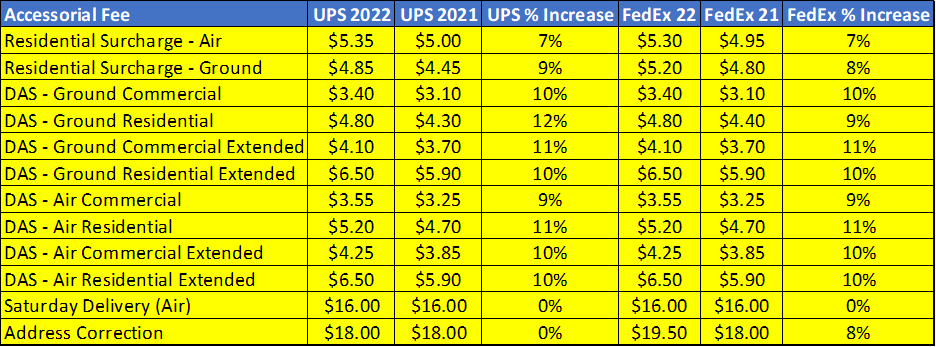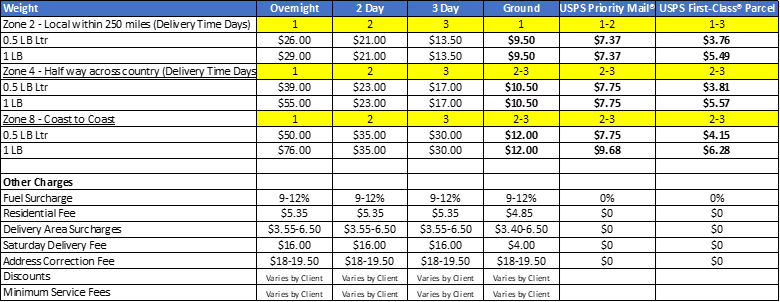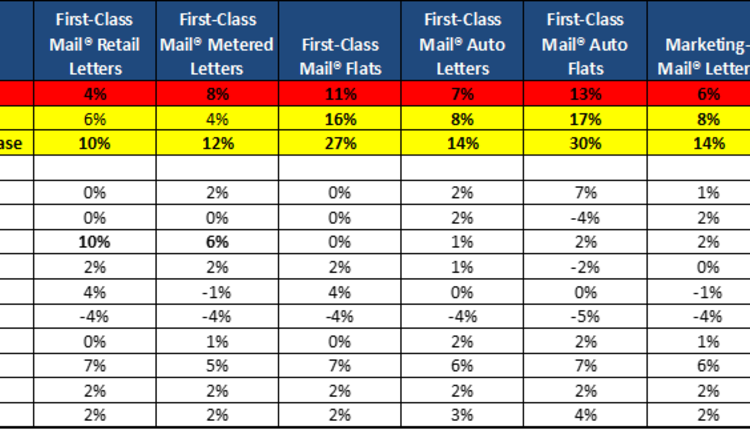With inflation, not to mention our reliance on document and parcel delivery, at its peak, this January, the carriers all raised rates to their highest levels. While we expect increases, this year is one of the largest, and it is important to understand the impact so you can properly budget or look for other savings alternatives. Both UPS and FedEx announced that they were having a 5.9% increase, but it is important to remember that this is overall. Based on multiple factors affecting your organization, the actual increase could be significantly higher, as you can see in Figure 1. Also, the USPS stated that its Priority Mail rates were going up 2.7%, but, again, this is overall. Most clients should expect to see higher increases. In this article, we will go over these changes, educate you on how rates are calculated, and provide savings strategies that can help minimize the financial impact.
Figure 1

There are three main factors that determine the rate of the item. The service level (based on delivery objectives), the zone to which it is going (distance away from where it is being sent), and the weight. In Figure 1, we break out zones 2-4 (fewer than 600 miles) vs. zones 5-8 (over 600 miles) because many organizations send most of their items to local clients vs. across the country. We also break out the weights because we find that many shipments are less than 10 pounds, which would include documents and small parcel. We highlighted the areas in yellow that are higher than the carriers’ listed increases. As you can see, based on what and where you are sending, the increases could be much larger. Overall, we are seeing higher increases for the lighter weight items going to local zones.
Accessorial Fees (Figure 2)

When we analyze our clients’ carrier invoices, we typically find that 20-30% of their bill is made up of accessorial charges, also called value added services. The rates of these fees have also gone up considerably and need to be factored into any budget. Figure 2 shows a subset of some of the most common fees. We highlight these because they are some of the most frequent, and the USPS does not charge for these services (unlike UPS and FedEx). It is important to focus on Delivery Area Surcharges (DAS) because 61% of all ZIP Codes in the US are assessed these fees. These ZIP Codes are viewed as less densely populated areas where the carriers charge an additional $3.40 to $6.50 added to the cost of the parcel.

In Example 1, you are sending a lightweight item to a residential address. The list price of the Ground shipment is $11.13, and even though the client has a 60% Ground discount, they have a minimum Service Charge of $7, negating $2.25 ($7-4.45) of their discount. When you add the Fuel Surcharge of 12%, the $5.20 Residential Fee and the $4.80 Delivery Area Surcharge, the item is $9.72 more than sending Priority Mail from the USPS, which would have the same delivery objective.

In Example 2, an additional savings strategy is to consider your carriers’ guaranteed Ground service for items in specific zones as an alternative to their air options because it can offer a significant savings and the same or faster delivery:
· Overnight items in Zone 2 (Local)
· Two-day items in Zone 2 and 3
· Three-Day items in Zone 2, 3, and 4
As you can see, both items will get there at the same time, but the Ground option is $4.48 less.
Many clients are using free, carrier-provided shipping tools (such as UPS CampusShip, for example) that make it difficult to make these comparisons. They will not have USPS rates, and the Ground comparisons are typically not displayed next to their air counterparts, making it difficult to see these as an option. We recommend having multi-carrier shipping tools that can display the rates for all options on one screen to make it easy for your users to make the best shipping decisions. We find this type of rate shopping can reduce costs in the four to 12% range and can help offset the annual increases in carrier rates.
Dimensional Rates
Dimensional weight is a major area that clients need to understand, since it can drastically increase their bills. Oftentimes, clients either are not entering the dimensions of their piece or are not considering the impact to the size of the box when they are making shipping decisions. UPS and FedEx will dimensionally rate items starting at about a six inch cube. The formula is length x width x height (in inches)/139. Example: Box that is 12” x 10” x 6” and is three pounds would need to be rated at six pounds. The USPS does not dimensionally rate items until the L x W x H is greater than 1728 or one cubic foot, and it divides the number by 166 (instead of 139), making them lower calculated weights. In this example, the item would be at the actual weight of three pounds. The chart below gives several comparisons of the difference in weight between the private carriers and the USPS.

The carriers are going to continue to raise rates at higher levels than we have seen in the past. Our reliance on delivery is increasing, and there are very few major suppliers who have increased leverage. Clients have less bargaining power in carrier rate negotiations, and fewer shipping costs are being passed back to the end recipient. The best way to reduce expenses is to have ways to compare the rates across multiple carriers and service levels at the point of shipment. You need to have the right tools in place that help your end users make the best decisions on a package-by-package basis. The free carrier tools will not provide this level of detail, and it is not practical to expect users to shift between multiple systems to make these decisions. The good news is that with the right tools, there are ways save money and offset these increases.
Adam Lewenberg, CMDSS, MDC, President/CEO of Postal Advocate Inc., runs the largest Mail Audit and Recovery firm in the United States and Canada. They manage the biggest shipping & mail equipment fleet in the world and their mission is to help organizations with multi-locations reduce mail and parcel related expenses, recover lost postage funds, and simplify visibility and oversight. Since 2011, they have helped their clients save an average of 58% and over $68 million on equipment, presort, avoidable fees, and lost postage. He can be reached at 617.372.6853 or adam.lewenberg@postaladvocate.com
This article originally appeared in the January/February, 2022 issue of Mailing Systems Technology.







![GettyImages-1170541989-[Converted]](https://cms-static.wehaacdn.com/mailingsystemstechnology-com/images/GettyImages-1170541989--Converted-.1803.widea.0.jpg)


